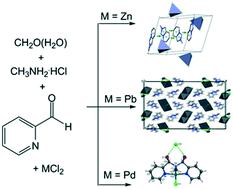当前位置:
X-MOL 学术
›
CrystEngComm
›
论文详情
Our official English website, www.x-mol.net, welcomes your
feedback! (Note: you will need to create a separate account there.)
Synthetic strategy towards halometallates with imidazo[1,5-a]pyridinium-based counterions
CrystEngComm ( IF 2.6 ) Pub Date : 2020-07-03 , DOI: 10.1039/d0ce00018c Olga Yu. Vassilyeva 1, 2, 3, 4 , Elena A. Buvaylo 1, 2, 3, 4 , Rostyslav P. Linnik 1, 2, 3, 4 , Dmytro S. Nesterov 5, 6, 7, 8, 9 , Vladimir V. Trachevsky 4, 10, 11 , Brian W. Skelton 12, 13, 14, 15
CrystEngComm ( IF 2.6 ) Pub Date : 2020-07-03 , DOI: 10.1039/d0ce00018c Olga Yu. Vassilyeva 1, 2, 3, 4 , Elena A. Buvaylo 1, 2, 3, 4 , Rostyslav P. Linnik 1, 2, 3, 4 , Dmytro S. Nesterov 5, 6, 7, 8, 9 , Vladimir V. Trachevsky 4, 10, 11 , Brian W. Skelton 12, 13, 14, 15
Affiliation

|
Organic–inorganic halometallates are a very promising class of compounds within the more general domain of organic–inorganic hybrid materials. The efficient approach for creating new hybrid halometallate salts is the design and use of monovalent organic cations, where the size, shape and electronic structure can be varied over wide limits, for introducing useful properties into hybrid structures. Therefore, we have prepared two new chlorometallate salts [L′]2[ZnCl4] (1) and [L′]n[PbCl3]n∞ (2) with 2-methyl-imidazo[1,5-a]pyridinium cations [L′]+ formed as a result of the oxidative cyclocondensation between formaldehyde, methylamine and 2-pyridinecarbaldehyde in water media. While the tetrahedral ZnCl42− anions show no connectivity in 1, the hybrid exhibits a pseudo-layered structure with organic and inorganic sublattices arranged parallel to the bc plane. In the crystal of 2, stacks of the aromatic cations alternate with one-dimensional stepwise chloroplumbate wires along the a direction. The use of PdCl2 as a source of metal ions in the same synthetic procedure did not result in a hybrid tetrachloropalladate but produced the cationic complex [PdClL′′]Cl (3) with trapped bis-hemiaminal L′′, an intermediate to imine. In the solid state, 3 with two stereogenic centres should be seen as a 50 : 50 racemic mixture of two optically-active compounds but it shows a meso structure in DMSO solution. Broad emission with a maximum at around 386 nm of 1 and 2 in solution (λex = 275 nm) originates from the organic component. Upon excitation at 214 nm, crystalline powder samples of 1 and 2 exhibit intense sky blue-light photoluminescence.
中文翻译:

咪唑并[1,5-a]吡啶鎓抗衡离子合成卤代金属盐的策略
在有机-无机杂化材料的更广泛领域中,有机-无机卤代金属盐是一类非常有前途的化合物。产生新的杂化卤代金属盐的有效方法是设计和使用一价有机阳离子,其中大小,形状和电子结构可以在很宽的范围内变化,以将有用的特性引入杂化结构中。因此,我们已经制备了两种新chlorometallate盐[L'] 2 [的ZnCl 4 ](1)和[L'] ñ [PBCL 3 ] Ñ ∞(2)用2-甲基-咪唑并[1,5-一个]吡啶鎓阳离子[L'] +甲醛,甲胺和2-吡啶甲醛在水介质中的氧化环缩合而形成。尽管四面体ZnCl 4 2-阴离子在1中没有连通性,但杂化体表现出伪层结构,有机和无机亚晶格平行于bc平面排列。在2的晶体中,芳香族阳离子的堆栈沿a方向与一维逐步氯代铅酸盐线交替排列。在相同的合成步骤中,使用PdCl 2作为金属离子的来源不会产生杂化四氯钯酸,但会产生阳离子络合物[PdClL''] Cl(3)被困的双半血L''(亚胺的中间体)。在固态状态下,具有两个立体生成中心的3应该被视为两种光学活性化合物的50:50外消旋混合物,但在DMSO溶液中显示出内消旋结构。宽的发射带的最大值在约386纳米的1和2中的溶液(λ EX = 275纳米)从有机成分起源。在214 nm激发后,结晶粉末样品1和2表现出强烈的天蓝色光致发光。
更新日期:2020-08-03
中文翻译:

咪唑并[1,5-a]吡啶鎓抗衡离子合成卤代金属盐的策略
在有机-无机杂化材料的更广泛领域中,有机-无机卤代金属盐是一类非常有前途的化合物。产生新的杂化卤代金属盐的有效方法是设计和使用一价有机阳离子,其中大小,形状和电子结构可以在很宽的范围内变化,以将有用的特性引入杂化结构中。因此,我们已经制备了两种新chlorometallate盐[L'] 2 [的ZnCl 4 ](1)和[L'] ñ [PBCL 3 ] Ñ ∞(2)用2-甲基-咪唑并[1,5-一个]吡啶鎓阳离子[L'] +甲醛,甲胺和2-吡啶甲醛在水介质中的氧化环缩合而形成。尽管四面体ZnCl 4 2-阴离子在1中没有连通性,但杂化体表现出伪层结构,有机和无机亚晶格平行于bc平面排列。在2的晶体中,芳香族阳离子的堆栈沿a方向与一维逐步氯代铅酸盐线交替排列。在相同的合成步骤中,使用PdCl 2作为金属离子的来源不会产生杂化四氯钯酸,但会产生阳离子络合物[PdClL''] Cl(3)被困的双半血L''(亚胺的中间体)。在固态状态下,具有两个立体生成中心的3应该被视为两种光学活性化合物的50:50外消旋混合物,但在DMSO溶液中显示出内消旋结构。宽的发射带的最大值在约386纳米的1和2中的溶液(λ EX = 275纳米)从有机成分起源。在214 nm激发后,结晶粉末样品1和2表现出强烈的天蓝色光致发光。











































 京公网安备 11010802027423号
京公网安备 11010802027423号